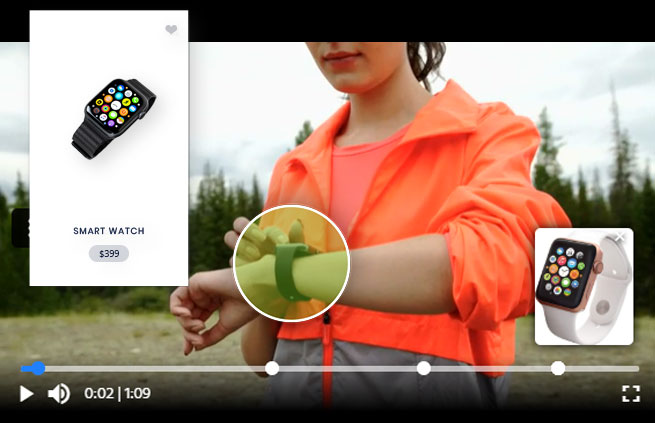Industry research suggests that around 96% of consumers find shoppable videos a desirable e-commerce feature that helps make purchasing decisions easier. On the sell side, 72% of businesses report that video improved customer conversion rates.
With that degree of consumer and business interest in a new approach to online retail shopping, AiBUY hopes to capitalize on its proprietary technology as a game-changer for live commerce.
Retailers have tried shoppable videos before. Though promising, they have not advanced universally beyond niche audiences. Marketers have had some encouraging success with the concept, depending on the platforms used.
Shoppable videos and live commerce present potential buyers with a blend of product videos containing links to checkout options on merchant websites. This approach adopts live commerce goals based on consumer-led and consumer-centric product discovery.
Founded in 2007, Texas-based AiBUY wants to drive that concept to its innovative marketing and commerce platform that offers retailers and consumers something unavailable elsewhere. The provider of video shopping tech serves the B2B space in the retail market segment.
According to AiBUY CEO Randy Bapst, the platform is built upon 83 patents in 35 countries.
“A lot of companies have tried to do this in the past. We have been working on it at this point for years and years to make it more seamless and usable for everybody on a larger scale that has not been done before,” AiBUY VP Dalaney Thompson told the E-Commerce Times.
Move the Needle Potential
The live commerce innovation to make this new platform work comes into play in the checkout phase. That is a patented technology that AiBUY developed, according to Thompson.
AiBUY’s shopping opportunities put people closer to the sale. Its solution is uniquely different from anything else available today, added Bapst.
“We give retailers the ability to monetize the content, placing items that would be for sale within their content and capable of an execution and a checkout without ever leaving the content,” he told the E-Commerce Times. “Those are the key value points the new platform drives to the equation.”
The element that makes in-content selling — and what Bapst predicts people will see a lot in the future — is how it is revolutionizing the way people engage. It eliminates marketers relying on viewers’ impulse buying or contending with a video hounding them to click a link to somewhere else. Instead, it enables sellers to create content.
“That is a little bit more aggressive than maybe the product placement and just hoping and praying that people will recognize the brand and go to the store and buy it,” he said.
In-content selling goes beyond bringing opportunities to influence the end user. That response is significant for retail, especially in the market today with content creators, influencers, and even editorial, digital content, he observed.
More Convenient for Shoppers, New Revenue for Sellers
As Bapst explained the new selling process, consumers can now read an online article about products in its entirety or watch streaming content with integrated shoppable ads. They can click to interact with the pictures and complete a seamless checkout process without leaving the article or video.

AiBUY’s Hot Spots feature designates product references anywhere on video content.
“It is more convenient. It is closer to the conversion. The result is multiple conversions from multiple vendors without losing the traffic paid for to aggregate,” he detailed.
He sees considerable value in that from the publishing side as well as for video and content creators since it is a challenge to get those viewers.
“So if you actually have somebody engaged in your content, here is a way you can now open up a revenue stream and monetize your content in a way that was not available before,” he noted.
True In-Content Shopping
AiBUY’s platform eliminates redirecting consumer traffic to complete the purchase. Many companies now offer what they claim to be content-shoppable engagement but are not entirely so. Even on Amazon, if shoppers want to add one or more items to their shopping carts, they have to go to a checkout page to complete additional purchases.
That is not the case with AiBUY’s AI-driven display platform, emphasized Bapst. It achieves what other companies are trying to do.
For instance, if a person is watching a video and likes the shoes someone on the screen is wearing, along with somebody else’s jacket and maybe even a plant, the viewer can purchase all the products from multiple vendors and never leave the presentation. They do not go to an exterior page to checkout, which eliminates all the drop-offs of viewers between the offer and the conversion.
No Tech Lock-In
AiBUY’s technology opens the door for a variety of options and existing software systems that the vendors use.
It might take AiBUY a few weeks to create the features a particular user wants. However, once it completes the configuration, it does not matter what platform uses the in-content selling solution. Which features are possible depends on the options the vendors select and the existing software platform.
“We are agnostic to platforms. It can be whatever platform you’ve got. It does not matter. Ultimately, it is a piece of code and a simple integration that we plug in,” said Delaney. “So many ways exist for vendors to utilize in-content presentations to influence people to participate.”
Multi-Industry Appeal
AiBUY is not a one-target marketing platform, and users are not limited to one industry, Bapst offered. Starting out, vendors onboard mostly wearable clothing, cosmetics, and sports.
“You name it. I mean, adopters are creators of content and merchandise or both who want to monetize or sell a product. That is the target user,” he said.
Bapst offered that the company is actively talking with various potential new users. Conversations are ongoing with organizations like the NFL, ESPN, cosmetic companies, and manufacturers. Users are not limited to verticals or to set industries.
User limitation only lacks imagination, suggested Bapst. Thompson agreed that much of the potential might even fall into the realm of a metaverse platform.
“That is what makes this concept so interesting with this kind of thought process and this idea that our platform can be utilized in multiple mediums like the gaming world or the virtual world,” she continued.
Thompson would like to see how that develops. The company does not have those marks on the line yet to set that integration up, she admitted.
“But I definitely think that it is within the realm of the direction things are going,” she concluded.
Integration demos are available on the AiBUY website.



























































Social Media
See all Social Media